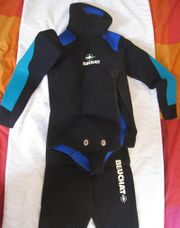Wetsuit

A wetsuit or wet suit is a garment sometimes worn by swimmers, surfers and divers for warmth and protection against sharp objects. It may be made of rubber, lycra or neoprene. It typically covers the whole body except the head, hands and feet and is usually quite close-fitting. A "shortie" has short sleeves and legs, and obviously offers less warmth.
A modern, warm-water wetsuit is mostly made from thin open-cell neoprene, which provides limited thermal protection for activities in cold water, but protects the wearer in warm water from sun exposure. Cold-water wetsuits are built differently, have seams which do not leak, and provide good protection from cold water (to about 45°F, or 8°C) for up to 60 minutes in shallow water (less than 10 metres or 33 feet). A wetsuit is usually lined with a nylon fabric to strengthen it and make it easy to put on and take off. Some newer wetsuits, usually marketed as "superflex," contain lycra in addition to neoprene to allow the suit to stretch (the panels of a wetsuit of this type typically contain 15-20% lycra). This counteracts neoprene's tendency to shrink with age; it also allows for some changes in the wearer's size without making the suit uncomfortable.
Wetsuits help to preserve body heat by trapping a layer of water against the skin; this water is consequently warmed by body heat and acts as an insulator. Water conducts heat away from the body approximately 25 times more efficiently than air, so an unprotected individual can succumb to hypothermia even in warm water on a warm day. Wetsuits are made out of closed-cell, foam neoprene, a synthetic rubber that contains small bubbles of nitrogen gas when made for use as wetsuit material. Nitrogen gas has very low thermal conductivity, so it reduces heat from the body (or the water trapped between the body and the wetsuit) from being lost to the water outside of the wetsuit. Some wetsuits of late have even begun to incorporate Merino wool and titanium fibers to add warmth characteristics, while keeping the thickness of the suit to a minimum. A wetsuit must have a snug fit to work efficiently; too loose a fit will allow water to escape from between the suit and the body, taking the body's heat with it. Flexible seals at the suit cuffs aid in the water retention. Neoprene is very buoyant, helping swimmers to better stay afloat, and for this reason divers need to calculate extra weight values based on the thickness of their suit to achieve neutral buoyancy underwater. The suit loses buoyancy and thermal protection as the bubbles in the neoprene are compressed at depth.
A wetsuit differs from a drysuit because water can get between the garment and the person's skin, forming an insulating layer.
Like other rubber garments, it may be worn as a fetish.
See also
External links
| Body region | Fetish wear | Bondage wear | Vanilla |
|---|---|---|---|
| Headwear | Hood Collar |
Bondage hood Posture collar Neck corset Mouth corset |
Veil |
| Torso | Corset Leotard |
Bondage corset Straitjacket | |
| Lower body | Suspender belt | Hobble skirt Inflatable leggings |
Hosiery |
| Hands | Armbinder/Monoglove Bondage mittens |
Gloves | |
| Footwear | Latex boots | Ballet boots | Boots Stockings |
| Full body | Catsuit/Zentai | Body bag Inflatable catsuit Punishment suit |
Unitard |
| [ Source ] | |||
| This page uses content from SM-201; the original article can be viewed here. |
